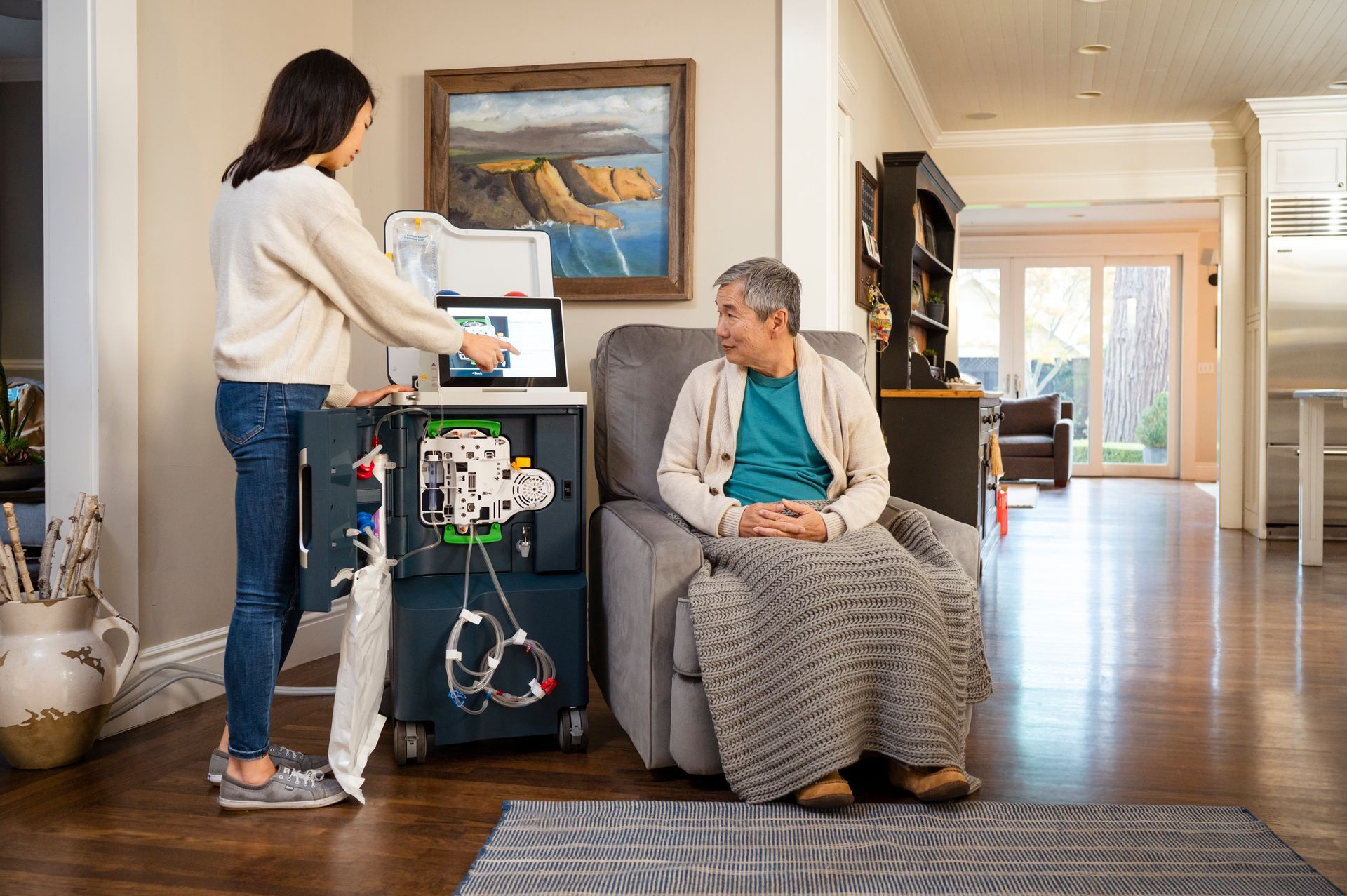Peritoneal Dialysis Treatment Coming Soon!
Written by: Vitality Dialysis
This is a subtitle for your new post

Dialysis is a therapy often required by individuals whose kidneys aren't working. It is a critically necessary medical treatment that removes waste products and excess fluids from the blood of people who struggle with acute kidney injury, late- to end-stage kidney disease, and kidney failure, including patients waiting for kidney transplants. Without adequate kidney function or using dialysis to take its place, these waste products and fluids will build up in the bloodstream, causing a fluid overload situation impacting the lungs and heart, and a toxin excess that could lead to death in just a few days. Dialysis can help people with kidney disease live full, productive lives for many years, but it is often a costly and time-consuming endeavor.
Vitality Dialysis transforms this experience by enabling patients to have hemodialysis treatments in the comfort of their own homes, eliminating the burdens of travel, time spent in clinics, and rigid schedules. This approach provides patients with more control, convenience, choice, and confidence as they navigate life with kidney disease.
But exactly what is hemodialysis?
What is Hemodialysis?
Hemodialysis is a process by which blood is passed through a dialyzer (artificial kidney) for the removal of water and toxins and then returned back to the patient. Since the patient's entire blood volume cannot be taken out and "cleaned" all at once, this process is usually completed over 3.5 - 4 hours. Utilizing a dialysis access (fistula, graft, or catheter), two tubes are connected to the patient via a sterile, closed system during treatment. One tube removes blood from the body, the other tube returns blood to the body. The dialysis machine involves the blood pump, sensors, and safety features necessary for treatment. Over the course of a hemodialysis treatment, the patient's blood volume is removed 40-60 times in an effort to expose as much blood to the dialyzer for fluid and toxin removal. Depending on your needs, you may need hemodialysis two, three, or more times a week.
Types of Hemodialysis
Hemodialysis can be done in a few different ways, depending on your medical needs and lifestyle concerns:
In-Center Hemodialysis
In-center hemodialysis refers to a dialysis clinic or "center" where nurses and technicians perform the treatment for you. While in-center care has been the standard for 60 years, this type of care model presents a variety of challenges for many patients. Averaging 3-4 treatments per week, patients continually report disruptions in schedule and lifestyle when dialyzing at clinics. Scheduling treatments around work, school, or family obligations can be difficult, and travel time to and from clinics often adds hours to an already lengthy process. Inclement weather, transportation costs, and fatigue from travel can further disrupt daily life.
Many clinics have limited chair time availability, forcing patients to choose a very inconvenient treatment time.
Additionally, several patients are driver-dependent. This adds another burdening factor when you are needing 3-4 treatments every week. In the event the driver cannot assist, the patient cannot dialyze.
Home Hemodialysis
Home hemodialysis offers unmatched freedom and flexibility for patients compared to in-center options. It takes place in the comfort of your own home, eliminating the need for travel and allowing you to create a schedule that works best for your life.
Hemodialysis nurses and technicians will come to your home initially to install the machines and train you and other members of your family about how to conduct your hemodialysis procedures and how to use the equipment safely and hygienically on your own time. Three different options exist under the home hemodialysis umbrella:
- Conventional Home Hemodialysis: This standard procedure typically consists of three weekly sessions, lasting from three to four hours each.
- Short Daily Home Hemodialysis: Newer technology enables patients to perform hemodialysis five to seven days weekly, with each session lasting about two hours.
- Nocturnal Home Hemodialysis: You perform nocturnal home hemodialysis overnight, as you sleep. Overnight home dialysis can remove more waste from the blood because the sessions are longer.

Regardless of which type of home hemodialysis you choose, the benefits are clear: you can schedule treatments around your life—not the other way around—and enjoy the comfort and privacy of your own home. Home dialysis also eliminates the need for frequent travel, saving you time, energy, and money while reducing the strain on your body.
Vitality Dialysis provides personalized training and ongoing support to ensure that you and your family feel confident managing your care. Our compassionate team is always just a call away.
It's pertinent to note that not all patients qualify for home hemodialysis nor desire their therapy to take place at home.
How Hemodialysis Works
Let’s go beyond the question, “What is hemodialysis” and move into exactly how hemodialysis works to filter and clean your blood in place of your kidneys.
What is a Dialyzer?
A dialyzer is an "artificial kidney" and involves thousands of fibers each with a semi-permeable membrane. The dialyzer is used to filter fluid and waste products from the bloodstream during a dialysis treatment.
How Does a Dialyzer Work?
The dialyzer contains thousands of hollow fibers made of a semi-permeable material. This allows only specific molecules (e.g., waste products, excess salts, and water) to pass through while retaining larger molecules like proteins and blood cells.
Two Compartments:
- Blood Compartment: The patient’s blood flows on one side of the membrane.
- Dialysate Compartment: A special dialysis solution (dialysate) flows on the other side. The dialysate contains a precise mixture of water, electrolytes, and other compounds to help balance the blood.
Blood Flow:
Blood is drawn from the patient (via vascular access, such as a fistula, graft, or catheter) and pumped into the dialyzer using a dialysis machine.
Filtration Process:
As blood flows through the hollow fibers in the dialyzer, waste products, excess electrolytes, and fluid move across the semi-permeable membrane into the dialysate by diffusion (movement of solutes from high to low concentration) and ultrafiltration (removal of fluid through pressure gradients).
Dialysate:
The dialysate carries the waste products and excess fluid away from the blood. It is continuously replaced with fresh solutions to maintain efficient cleaning.
Cleansed Blood:
The cleaned blood is returned to the patient’s body through vascular access.
What Happens Before Hemodialysis?
In order for blood to flow between you and the dialyzer, vascular access needs to be created, allowing a connection between you and the machine. There are three access types available for hemodialysis:
- Arteriovenous (AV) Fistula—The most common, longest-lasting, and safest option that reduces the chance of blood clots. About two to three months before you need to start dialysis, a surgeon will create an artificial connection (anastomosis) between an artery and vein usually in your non-dominant arm. This AV fistula will develop an outflow vein suitable for hemodialysis use and necessary for frequent needle insertions. AV fistulas must undergo a maturation period which can take 2-4 months.
- Arteriovenous (AV) Graft—This is typically an option for patients who do not qualify for an AV fistula. AV grafts historically have a higher risk of blood clots and infections. It is, however, a faster option than a fistula in that no maturation period is necessary. Most grafts can be used within a week or two after insertion. With an AV graft, a surgeon connects an artery and a vein using a synthetic tube. Hemodialysis takes place by placing two needles into the synthetic tube for the removal and return of blood.
- Central Venous Catheter (CVC)—A surgeon inserts a synthetic catheter into your upper chest, leaving one end exposed for dialysis connection and the other end tunneled into the right atrium of your heart via an internal jugular or subclavian vein. Catheters generally come with a higher risk of infection, blood clots, and internal scar tissue.
Regardless of which kind of vascular access you and your doctor decide to use, keep the area clean and safe by following access care instructions. Preventing infections is the best pathway to success.
What Happens During Hemodialysis?

During a hemodialysis session, you should be seated comfortably where you can relax for the amount of time required for your treatment. Your nurse, technician, you, or a trained family member will connect the hemodialysis machine to your vascular access point, and the dialyzer will begin to filter and clean your blood. You are free to read, watch TV, nap, or use a mobile device as the process proceeds.
What Happens After Hemodialysis?
After the session is finished, whether in-center or
home dialysis, you will be disconnected from the hemodialysis machine and you're free to go about your day. While patients have reported cramping, fatigue, low blood pressure, nausea, and lack of energy following their hemodialysis session, these symptoms are not normal and need to be immediately addressed. Talk to your nursing team and doctor. It is likely your dialysis prescription needs to be adjusted. Dialysis may leave you feeling a bit tired, but it should not incapacitate someone from carrying on through their day and performing normal functions.
How Long Can You Live on Hemodialysis?
Hemodialysis can extend your life, and many patients can experience active, full lives for anywhere between five and even 30 more years. Life expectancy greatly depends on many other variables, including how carefully you stick to your treatment plan. Your dialysis team will work with you on sticking to a consistent hemodialysis schedule, managing your diet, monitoring medications, and adjusting other lifestyle factors to help you enjoy a high quality of life for as long as possible.
Benefits of Hemodialysis
The greatest benefit of hemodialysis is that it can save your life if your kidneys are no longer able to function. Although hemodialysis does not do everything your kidneys can do, nor is it a cure for kidney disease or failure, it can keep you alive and help you live a full, active life for many years if you follow your treatment plan.
Risks and Side Effects of Hemodialysis
Like any other life-saving medical treatment, hemodialysis also carries risks and side effects, many of which can be mediated with help and adjustments guided by your healthcare team. Some of these risks include low blood pressure, high blood pressure, muscle cramps, fatigue, itchy skin, sleep disturbances, restless legs, anemia, blood clots, infections, and inflammation.
What to Consider when Choosing a Dialysis Treatment Plan
It can be overwhelming to learn that you need dialysis, and every person has different life circumstances to consider when deciding how dialysis will be administered. It’s important to discuss all of your options and concerns with your doctor so that you can make decisions that will give you the most benefits and fewest risks while helping you live the life you want to lead as much as possible. Here is a list of questions and considerations you’ll want to go over with your doctor to help you make informed decisions about dialysis:
- What is hemodialysis compared to other types of dialysis?
- How will hemodialysis impact my daily routine (consider work, school, and lifestyle impacts)?
- What type of hemodialysis would work best for me?
- Am I a candidate for home hemodialysis?
- How will insurance cover treatments?
- What are the hidden costs of dialysis? (Travel, work schedule impacts)
- What dietary adjustments should I make?
- How much fluid intake should I aim for?
- How will I need to adjust my medications?
- How can I lower my risks of side effects?
When to Call a Doctor
Once you’ve started a hemodialysis treatment plan, follow all of your treatment details to the letter and you should have a good outcome. Keep track of things like your dose number and always discuss any concerns you have with your nurse or technician. Call a doctor if you notice any unusual or alarming symptoms or situations, including:
- You notice changes to other body functions or body parts
- You have fallen or injured yourself
- Dialysis treatments do not have their intended benefits
- You have an infection
- You have symptoms of a blood clot
Home Dialysis Made Simple—Get in Touch with Vitality
Living with dialysis does not have to completely disrupt your life. Partnering with the right dialysis provider and creating a comprehensive care plan that fits your lifestyle can greatly improve and extend your life. Vitality Dialysis offers home hemodialysis services across Illinois, Wisconsin, and Michigan, giving you the freedom, flexibility, and convenience of receiving high-quality care in the comfort of your own home—without the hassle of frequent clinic visits.
From answering your questions to helping you manage your equipment and treatments confidently, the Vitality Dialysis team is committed to helping you live your best life.
Contact us today to learn more about the benefits of home hemodialysis and how we can help you take control of your kidney care.

© Copyright 2024 | Vitality Dialysis Privacy Policy |
Website imagined and executed by RivalMind.
Contact






